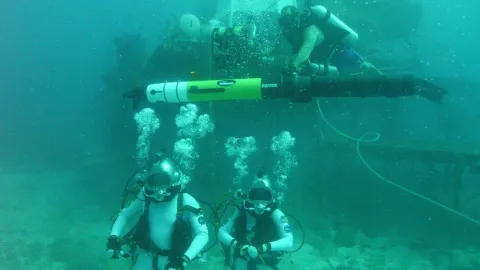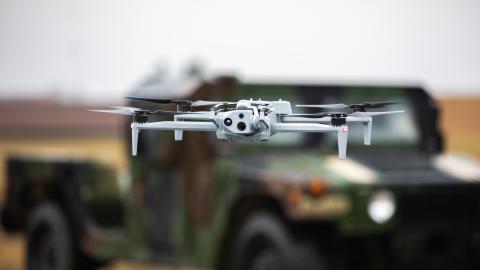Mr. McGrath's testimony begins at 36:45.
Thank you Chairman McCain and Ranking Member Reed, and all the members of the Senate Armed Services Committee for the opportunity to testify and to submit this written statement for the record.
I am a defense consultant by trade, specializing in naval strategy. In early 2014, I joined with Seth Cropsey of the Hudson Institute to found a think tank devoted to Seapower, known as the Hudson Center for American Seapower. All of my adult life has been spent either in the Navy or working on matters of naval operations and strategy.
On active duty, I commanded a destroyer, and I was the team leader and primary author of the 2007 USN/USMC/USCG maritime strategy known as “A Cooperative Strategy for 21st Century Seapower. Since leaving active duty in 2008, I have written and spoken widely about preponderant American Seapower as the element of our military power most that most effectively and efficiently promotes and sustains America’s prosperity, security, and role as a world leader.
It is an honor to appear before you and in the company of my esteemed colleagues. The nature of this hearing—an inquiry into the continuing relevance of the roles and missions compromise reached at Key West in the late 1940’s—provides the opportunity for a more generalized discussion of the relative merits of Seapower, land power, and air power in the national security strategy of the United States of America. And while the Key West Agreement went a long way toward containing the inter-service rivalry that characterized the immediate post-war defense bureaucracy, it took the Goldwater-Nichols Act of 1986 to finish off the Services as effective advocates for their own particular brand of military power, while creating an atmosphere of “go along to get along” in which consensus is viewed as the highest bureaucratic attribute. In fact, the interaction of Key West and modern Jointness is primarily responsible for the strategic sclerosis that predestines this nation—in these austere times—to a military that is increasingly misaligned with our interests and the strategic environment.
The primary casualty of seventy years of Key West and Goldwater-Nichols has been the loss of forceful, uniformed advocacy for the particular operational and strategic benefits of generally Service-specific military modalities. The contributions of Seapower, land power, and air power in anything more than the tactical and theater operational sense has in no small measure been sacrificed on an altar of “Jointness” in which the contributions of all Services must blend harmoniously, and in which unseemly advocacy—and its likely threat to Jointness—is a guaranteed career shortener.
That is why this hearing and this Committee’s willingness to take hard look at where we are with Goldwater-Nichols—nearly thirty years after its passage--is so important.
Our fighting force has become the envy of the world, and Jointness has a lot to do with that. Our ability to synthesize and synchronize the fires and effects of the four armed services in the space and time of our choosing is unmatched. Additionally, Jointness has the potential to create efficiencies in acquisition, so long as requirements and performance specifications are not unduly compromised in order to attain the “one size fits all” (or most) approach.
Where Jointness has ill-served this country is at the level of strategy-making, both in terms of military strategy and the military’s contribution to the making of Grand Strategy.
Jointness, Strategy, and Resources
Eight years ago while on active duty, I was the team lead and primary author of a document called “A Cooperative Strategy for 21st Century Seapower”, which was a tri-service document (Navy, USMC, Coast Guard) that boldly proclaimed itself a “maritime strategy”, a term that had not been used to describe any one of a half-dozen Navy and Department of the Navy strategic documents in the previous two decades—since the seminal “Maritime Strategy” of the Reagan era.
In point of fact, Goldwater-Nichols and the rise of the Combatant Commanders created a sense among many in the national security field that strategy was no longer the purview of the Services, and that to the extent strategy was to be made, it would be done at the Combatant Commands and the Joint Staff. This view was summed up in a conversation I had in early autumn of 2007, just before the new maritime strategy was to debut. In it, my interlocutor, a friend who is now occupying a position of great responsibility in the Department of Defense, told me that “Services make budgets, not strategy. You guys (the Navy) have no business in writing strategy.” He was not alone in this assessment.
We forged ahead with the Maritime Strategy in spite of those who felt strongly that we had no mandate to do so, and the result was generally well-received. In dissent, one prominent navalist opined that it (the strategy) was not Joint enough, and that we ignored the important contributions of the other Services. Keep in mind, this was a Seapower strategy, designed in no small measure to explain modern American Seapower and its unique contributions to national security and prosperity.
The point of this discourse is to raise the issue that Jointness has risen to the level of attribute above all other attributes—not only in how the force fights, but in how it makes strategy. Military strategy and its contribution to grand strategy take as a starting position, a Joint force that is constituted from the pieces and parts and roles and missions largely enshrined at Key West. Key West essentially locked the contributions in place, with Goldwater-Nichols then enforcing the notion that while the individual service modalities were of course important, it was ONLY in their blending—in largely consistent shares—that goodness could be had.
We can see evidence of this in how base budgets have been allocated in the post-Vietnam era. We often hear of a “1/3, 1/3, 1/3” split, but this is not correct. In fact, the Services only actually split 80% of the budget, as 20% is consumed by DoD activities. That 80% however, has been relatively consistently allocated over the years, with the Department of the Navy generally receiving the largest share (it contains two armed services), the Department of the Air Force next, and the Department of the Army the least. What is interesting though, is that the proportions remain relatively equal irrespective of the national military strategy. Put another way, we have had numerous defense-wide reviews since Goldwater-Nichols, to include the Base Force, the Bottom-Up Review, several National Security Strategies, several Quadrennial Defense Reviews, and the 2012 Defense Strategic Guidance. And although these reviews addressed markedly different security environments, the proportions allotted to the military departments remained generally stable. Supplemental funding is not included in this comparison.
How can this be? How can base budgets remain relatively stable across a number of dramatically different security environments, including America as “hyper-power”, the War on Terror, and the Rebalance to the Pacific? The answer is that Key West and Goldwater-Nichols have created an atmosphere in which comity and consensus are the coin of the realm, and that consensus is “purchased” with defense spending that ensures each of the Services generally get much of what they want and rarely get all of it.
Redundancy, Inefficiency, and Risk
The roles and missions division that emerged from Key West enshrined redundancy and inefficiency, but in the process, these overages helped buy down risk, especially as the Cold War progressed. While existential threats lurked, a certain amount of inefficiency and redundancy was worthwhile, and strategically unobjectionable. It is important to remember that the reason Secretary Forrestal convened the Chiefs at Key West was in order to gain efficiency, to economize. Although he was relatively unsuccessful in this regard, Key West created a roles and missions architecture that could be relatively easily enlarged and diminished in response to the perceived level of threat from the Soviet Union. And while Eisenhower eventually came to rely more heavily on nuclear weapons rather than conventional (with the USAF receiving nearly ½ the defense budget late in his second term), he did little to alter the roles and missions of the Services. Additionally, he had the luxury of spending nearly 10% of GDP on defense, nearly triple the proportion we allocate today.
It cannot be stressed enough that Key West was convened largely to reach efficiencies and to economize, and not as a means to achieve strategic coherence or wholeness. As we face what appears to be a new era of great power contention, I am concerned that as we look at roles and missions, we do so not as an exercise in efficiency, but in the quest for the allocation of resources and forces best suited to deter and if necessary, win great power war.
Put another way, the roles and missions debate is potentially less interesting than a debate about how those roles and missions are prioritized, and that prioritization discussion necessarily involves the concept of risk. That said, it seems strategically unwise to continue to spend a declining share of our national wealth on defense while maintaining the current departmental allocation consistency. We are creating a Joint force that is simply a smaller version of its predecessors, capable of doing fewer things, to a lesser extent, in fewer places, without any diminishing of the responsibilities assigned to it. We can go in one of three directions. We can continue to go in the direction that we are, which will ill-position us to protect and sustain our interests in an era of renewed great power contention. This is the most risky path but also the most likely. We can dramatically increase defense spending across the board, and increase the size and readiness of the Armed Services even as we modernize them, which is the least risky path, but in the absence of a triggering event or a political sea-change, highly unlikely. Or we can continue with the same general total outlay of defense spending but favor certain military roles over others. This is option is less risky than the path we are on, but it is potentially as politically unlikely as the broad based increase in defense spending.
I wish to be on record as supporting the second option, a broad increase in military spending across the board. I believe this nation is dangerously ill-prepared to move forward in an era of great power contention, and I believe that the trajectory we are on will only decrease our fitness for these challenges.
If We Prioritize, Prioritize Seapower
Given that the political conditions for a broad increase in defense spending are unlikely to be achieved, and given that simply shrinking the current force will only increase the mismatch between our force and its likely operating environment, we must then consider placing bets on certain aspects of our military power; relying on them to a greater extent while we de-weight other capabilities, not because they are unimportant, but because they are less important to the missions of conventional deterrence and/or because such capabilities can be more rapidly reconstituted than other more capital intensive aspects of the force.
In my view, if a well-conceived strategic approach were taken that 1) weighted deterring and winning great power war higher than any other military endeavor and 2) allowed no sacred cows, modern American Seapower would be prioritized over land power and aerospace power. This is not to say that America does not need land and aerospace power; we certainly do. But the Department of the Navy is essentially a microcosm of the Joint Force as presently constituted. It clearly has the overwhelming amount of Seapower, although the Army has a large number of watercraft. It has the world’s most mobile air component, though the Air Force clearly contains campaign level, war-winning air power. And it has the world’s most feared middleweight land force, delivered from the sea with mobility and flexibility, although the Army is clearly our most powerful land force. In other words, I am an advocate for land power and air power-and I believe they can most efficiently be delivered from the sea in order to protect and sustain our interests around the world. Additionally, if properly resourced, the land and air power contained within the units of issue of modern naval power—the Carrier Strike Group and the Amphibious Ready Group, would be sufficient for much of the day to day work of military diplomacy, assurance, presence and deterrence around the world, and would be the force upon which the war-winning power of the Army and the Air Force would marshal if a conflict outstripped available naval power.
However, the Navy and Marine Corps as presently constituted would be ill-suited to this work. We are sized for peacetime forward presence of credible combat power in two theaters at a time—currently the Far East and the Arabian Gulf/Indian Ocean region. Our 271 ship, 186K Marine force is insufficient to service these forward deployed combat hubs, and worse, our national interests demand a return in force to the Mediterranean—where turmoil and unrest throughout North Africa and the Levant, threats to our ally Israel, and a new Russian “keep out” zone developing in the Eastern Mediterranean require U.S. answers.
A Navy and Marine Corps capable of providing continuous and indefinite presence, assurance, and deterrence in three theaters simultaneously would necessarily be larger than the current force. It would be built around 15 Expeditionary Strike Forces each of which is comprised of a large, nuclear powered aircraft carrier, an amphibious assault ship, 8-10 surface combatants, two additional amphibious ships, two loosely attached attack submarines networked into an undersea constellation of unmanned, unattended, and or fixed surveillance, sensors, and weapons, shore-based maritime patrol aircraft and integrated maritime intelligence, surveillance, and reconnaissance unmanned platforms. This force would take decades to achieve, and would likely be in the neighborhood of 450 ships and 220,000 Marines.
In fact, it is the time associated with achieving this force that argues strongly for moving quickly and investing steadily in peacetime. The framers of our Constitution faced a similar dilemma to what we face today. In relative terms, it was then—and remains today--less difficult (and expensive) to “…raise and support Armies…”, than it is to “…provide and maintain a Navy” (U.S. Constitution Article I Section 8). Recently, the Army Chief of Staff gave a speech in which he attempted to dispel a number of “myths” about warfare. One of these myths was that “armies are easy to regenerate”. This is of course, a straw man, as no thoughtful analyst considers it “easy” to regenerate an Army. The point though—one that the framers foresaw in the language of the Constitution—is not that it is easy to raise an army, but that it is EASIER than raising a Navy. In this regard, the Air Force is much more like the Navy than the Army. In simple terms, building ships takes a long time, and in our present industrial base—where there are few places that proper warships can be built—there is little or no surge capacity to “ramp up” in an emergency.
Geography is Not Destiny, but It Matters
Another reason to privilege the land power and air power resident in the sea power of the Department of the Navy is the great gift of geography that we enjoy. Our border nations are not military threats to our security. As the world’s most powerful economic nation, our interests are global, and protecting and sustaining them requires the projection of power and influence across thousands of miles. This extended quotation from Congressional Research Service analyst Ron O’Rourke article in the Naval Institute’s Proceedings (Jan 2012) says it best:
“Most of the world's people, resources, and economic activity are not in the Western Hemisphere, but in the other hemisphere, particularly Eurasia. Consequently, a key element of U.S. national strategy, going back many decades, has been to prevent the emergence of a regional hegemon in one part of Eurasia or another, because such a hegemon could deny the United States access to some of the Eastern Hemisphere's resources and economic activity. Preventing this is a major reason why the U.S. military is structured with force elements-including significant naval forces, long-range bombers, and long range airlift-that enable it to cross broad expanses of ocean and air space and then conduct sustained, large-scale military operations upon arrival. The United States is the only country with a military designed to do this. The other countries in the Western Hemisphere don't attempt it because they can't afford it, and because the United States is, in effect, doing it for them. Countries of the Eastern Hemisphere don't do it for the very basic reason that they're already in that hemisphere, where the action is. Consequently, they instead spend their defense money on forces for influencing events in their own neighborhood.”
Given our propitious geography and our friendly neighbors, there is a logical argument to be made to keep the land and airpower of the Department of the Navy in highest readiness with global capacity, while keeping the war-winning combat power of the U.S. Army’s land power and the U.S. Air Force’s air power largely—but not exclusively—garrisoned in the United States in smaller numbers than we have been used to. The nation would necessarily have to think through how most effectively to ramp up these two campaign level Services, and a more fluid mix of active, reserve and National Guard forces would likely result. Those elements of the Army and Air Force that support the day to day operations of the Navy and Marine Corps would also be kept in highest readiness, as would those portions of the Army that most resemble the capital intensive nature of the Navy and Air Force—specifically Army Aviation and Air and Missile Defense.
The greatest risk of this Seapower-centric approach is that we simply could not generate enough “war winning” combat power fast enough to prevent a “fait accompli”, especially one not proximate to the sea (for instance, Central Europe). Mitigating this threat would necessarily involve a greater reliance on the land forces of friends and allies. The risk could not however, be eliminated.
Conclusion
The most likely direction this nation will head (and the most dangerous) is to continue on the path it is on, a path to a smaller force that is increasingly inappropriate to the emerging security environment. This is because the forces of inertia are strong, both in the Pentagon and here on Capitol Hill. Additional money for defense seems unlikely, and just as unlikely would be a strategic re-prioritization.
The best option then would be to embark on a broad based defense increase, one that would grow the current force as allocated both in size and in capability. This I believe to be the soundest, most strategically wise course to take as China and Russia begin to assume larger roles in the world, and while spending more on defense would be a difficult political pull, it is probably more likely to happen than a strategic allocation of resources that challenges current paradigms and rice bowls.
Should the nation move in the direction of a dialogue that would be less risky than the current path and less expensive than the broad based defense build-up, then shifting resources and priorities to the Department of the Navy to enable it to provide the global, day-to-day management force while the other Military Departments concentrate on support to those routine and crisis response operations and most importantly, the provision of war-winning, heavy, campaign level land and air power, is advised.















